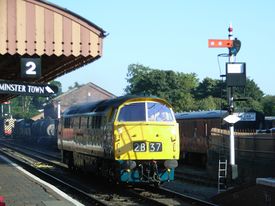BR Class 52 D1013 Western Ranger
| BR Class 52 D1013 Western Ranger | |
|---|---|
 D1013 Western Ranger at Bewdley in 2009 | |
| Built By | BR Swindon Works |
| Configuration | C-C |
| Power type | Diesel Hydraulic |
| Status | Under overhaul |
| Loco Number | D1013 |
| History | |
| Built | 1962 |
| Designed By | British Railways |
| Type | Class 52 |
| 1977 | Purchased by private owner |
| 1978 | Moved to SVR |
| 2009 | Overhaul began |
| Technical | |
| Length | 68ft |
| Weight | 108t |
British Railways (BR) assigned Class 52 to the Type 4 diesel-hydraulic locomotives built between 1961 and 1964 for BR(W). All were given two-word names beginning "Western", hence the type became known as Westerns.
Contents
D1013 in service
D1013 Western Ranger was outshopped from BR Swindon Works in December 1962. Following service at Cardiff Canton, Old Oak Common, Swansea Landore and Plymouth Laira, Western Ranger was withdrawn from service in 1977 after around 1.3 million miles in service.
D1013 in preservation
On 14 May 1977 D1013 was purchased from BR by Holdsworth Conversions Ltd., a company owned by Mr Richard Holdsworth, a member of the Western Locomotive Association. He put the locomotive under the care of the WLA. Following purchase the locomotive was repainted in original maroon livery. In company with D1062 Western Courier, D1013 moved to the Paignton & Dartmouth Railway, and following tyre turning at Cardiff Canton both arrived on the SVR on 29 September 1978.
In 1982, Western Ranger was used in the filming of the BBC TV sit-com L For Lester.
On 11 May 1984, D1013 was the first SVR locomotive to work onto the newly acquired Kidderminster site, hauling a load of sleepers for installation at the station which still under construction at the time.[1]
In 1985 Holdsworth Conversions Ltd. became insolvent and the receiver advertised the locomotive for sale. The WLA informed the receiver that major parts were owned by the Association, removal of which would render the locomotive out of gauge for removal. Sale was agreed and on 16 October 1995 ownership passed to Roger Smith, remaining under care of the WLA. On 22 March 2000 ownership passed to Western Ranger Limited, before being passed to the WLA.
On 10 October 2009 she was withdrawn for overhaul at Bridgnorth, with rewiring a particular priority. Work is progressing, with D1013 moving to the Diesel Depot on 25 November 2018 to facilitate the rest of her overhaul.[2]
See also
Diesel Locomotives
SVR-based locomotives visiting other events
Rolling stock currently under restoration
References
Links
Western Locomotive Association website
British Rail Class 52 on Wikipedia
| ||||||||||||||||||||||||||||||||||||||||||||||||||||||||||||||||||||||||